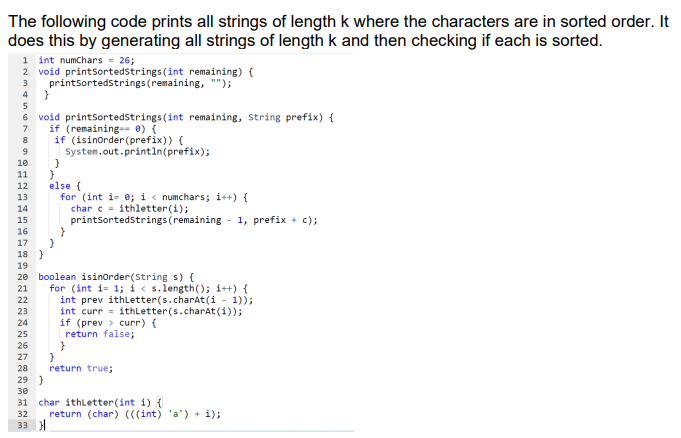Find the Big-O and explain why:
Database System Concepts
7th Edition
ISBN:9780078022159
Author:Abraham Silberschatz Professor, Henry F. Korth, S. Sudarshan
Publisher:Abraham Silberschatz Professor, Henry F. Korth, S. Sudarshan
Chapter1: Introduction
Section: Chapter Questions
Problem 1PE
Related questions
Question
Find the Big-O and explain why:

Transcribed Image Text:The following code prints all strings of length k where the characters are in sorted order. It
does this by generating all strings of length k and then checking if each is sorted.
1 int numchars = 26;
2 void printsortedstrings (int remaining) {
printsortedstrings(remaining, "");
3
4
5
6 void printsortedstrings (int remaining, String prefix) {
if (remaining-- 0) {
if (isinorder(prefix)) {
System.out.println(prefix);
7
10
11
else (
for (int i- e; i < numchars; i++) {
char c= ithletter(i);
printsortedstrings (remaining - 1, prefix + c);
12
13
14
15
16
17
18 }
19
20 boolean isinorder(String s) {
for (int i= 1; i< s.length(); i++) {
int prev ithletter(s.charAt(i - 1));
int curr = ithLetter(s.charat(i));
if (prev > curr) {
return false;
21
22
23
24
25
26
27
28
return true;
29 }
30
char ithLetter(int i) {
return (char) (((int) 'a') + i);
31
32
33 )|
Expert Solution
Step 1
Time complexity is a measure of the amount of time an algorithm takes to solve a problem as a function of the size of the input to the problem.
It describes how the running time of an algorithm increases as the size of the input increases.
Time complexity is usually expressed using "big O" notation, which gives an upper bound on the growth rate of the running time as a function of the size of the input.
Trending now
This is a popular solution!
Step by step
Solved in 2 steps

Knowledge Booster
Learn more about
Need a deep-dive on the concept behind this application? Look no further. Learn more about this topic, computer-science and related others by exploring similar questions and additional content below.Recommended textbooks for you

Database System Concepts
Computer Science
ISBN:
9780078022159
Author:
Abraham Silberschatz Professor, Henry F. Korth, S. Sudarshan
Publisher:
McGraw-Hill Education

Starting Out with Python (4th Edition)
Computer Science
ISBN:
9780134444321
Author:
Tony Gaddis
Publisher:
PEARSON

Digital Fundamentals (11th Edition)
Computer Science
ISBN:
9780132737968
Author:
Thomas L. Floyd
Publisher:
PEARSON

Database System Concepts
Computer Science
ISBN:
9780078022159
Author:
Abraham Silberschatz Professor, Henry F. Korth, S. Sudarshan
Publisher:
McGraw-Hill Education

Starting Out with Python (4th Edition)
Computer Science
ISBN:
9780134444321
Author:
Tony Gaddis
Publisher:
PEARSON

Digital Fundamentals (11th Edition)
Computer Science
ISBN:
9780132737968
Author:
Thomas L. Floyd
Publisher:
PEARSON

C How to Program (8th Edition)
Computer Science
ISBN:
9780133976892
Author:
Paul J. Deitel, Harvey Deitel
Publisher:
PEARSON

Database Systems: Design, Implementation, & Manag…
Computer Science
ISBN:
9781337627900
Author:
Carlos Coronel, Steven Morris
Publisher:
Cengage Learning

Programmable Logic Controllers
Computer Science
ISBN:
9780073373843
Author:
Frank D. Petruzella
Publisher:
McGraw-Hill Education